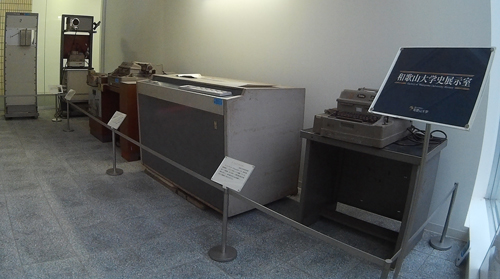

- Home >
- Artifacts of IP Heritage >
- 2012 >
- MADIC-IIA System
MADIC-IIA System


| Manufactured in | 1963 |
|---|---|
| Manufactured by | Matsushita Communication Industrial (now, Panasonic Mobile Communication) |
| Owner | Wakayama University |
| Location of historical materials | Gallery of Wakayama University History(located in University Library), Sakaedani 930, Wakayama-city, Wakayama, 640-8510 |
| Visitor information | Open to the public |
| Contact | General Affairs Section, Academic Information Division tosho3f@center.wakayama-u.ac.jp |
MADIC-IIA is a small-sized transistor-based computer for scientific and engineering computation developed by Mtsushita Communication Industrial (now, Panasonic Mobile Communication) in early days of Japanese computers. The product commercialization of MADIC II was planned after MADIC I was prototyped in April 1959 based on Electrotechnical Laboratory's ETL Mark IV. A group headed by Kinichiro Osugi started developing the first commercial product MADIC-IIA with unique features and completed it in October 1961, which was delivered to the computer center of Japanese Electronic Industry Development Association.
MADIC-IIA used dynamic flip-flop circuits based on a single transistor for logic circuits and a magnetic durum made by Matsushita for internal memory. By using the binary serial arithmetic system and arranging registers on the magnetic drum, it greatly reduced the component count and achieved higher reliability, greater compactness and lower cost. It also realized a small-sized computer and improved the operability.
About 50 kinds of scientific/engineering subroutines, a symbol input program called SIP and a small ALGOL compiler were developed. These together with a hardware floating point unit greatly improved the usability of the system.
A MADIC-IIA system was installed at the Faculty of Economics, Wakayama University in 1963 and was used for the research in econometrics and statistics and for education. This system including peripheral devices is preserved at Wakayama University and is exhibited at its campus.
